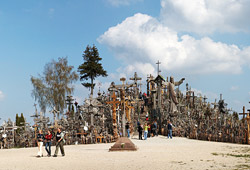History
The Hill of Crosses is located about 12 kilometres to the north of Šiauliai, in a field not far from the Šiauliai–Riga railroad. Oblong and not very large, the hill itself is sunken in the middle and completely covered by a dense of labyrinth of crosses. A wooden castle stood here in the middle ages, referred to in chronicles as “Kula”. The Livonian army destroyed it in 1348, after which the hill remained bare for centuries.
In the middle of the 19th century, people began to place crosses on the old castle hill. Locals say that the first crosses were erected to petition God for health. Others say crosses were first placed here to commemorate those who died in an 1863 uprising against the Russian occupiers. After suppressing the revolt, the Tsarist authorities banned the erection of crosses, punishing the owners of land where any crosses still stood and tearing them down. Pious people refused to stop setting up crosses, but did seek more remote locations to do so. The Hill of Crosses was just such a place, and it continually expanded despite the prohibitions of the Tsarist authorities and the ravages of World War I. In the period between the two world wars, the hill flourished. Many began coming here to pray, and Masses were celebrated. Large crowds would gather on feast days during the summer, especially during the annual Hill of Crosses Indulgenced Feast in mid July.
During the Soviet occupation, placing crosses on the hill was strictly forbidden. Pilgrims were tracked and punished, and, several times, bulldozers were used to annihilate all the crosses on the hill, and the roads leading to the site were closed. At one point, the authorities even threatened to flood the place. But the more intense the efforts to destroy the Hill of Crosses became, the more energetically was it regenerated. People would erect crosses at night, without regard to dangers, bans or persecution. The Hill of Crosses became a symbol of heroic resistance to the restriction of religious freedom.
After Lithuania regained independence, pilgrims began streaming to the Hill of Crosses. People began erecting crosses also at the foot of the hill as it became hard to find free space on the hill itself. The most significant event in the history of the Hill of Crosses, and one which spread its fame throughout the world, was the visit of Pope John Paul II on September 7, 1993. The Holy Father prayed at the Hill of Crosses, celebrated Holy Mass there and addressed an immense crowd that had gathered. In 1994, a cross that Pope John Paul II had donated was erected at the Hill of Crosses.
After his trip to Lithuania, while visiting the Franciscan monastery on Mount La Verna in Italy, John Paul II encouraged the Franciscans to build a sanctuary by the Hill of Crosses. The resulting monastery was blessed on July 8, 2000.
A new page in the history of the Hill of Crosses was turned in 1997, when the diocese of Šiauliai was created. The Hill of Crosses has become a sort of heart of the new diocese, its main shrine after the cathedral. On July 13, 1997, the day he took possession of the cathedral, Šiauliai Bishop Eugenijus Bartulis placed a cross at the Hill of Crosses with the inscription: “Lord, bless the diocese of Šiauliai.” Shortly after that, he revived the annual Indulgenced Feast of the Hill of Crosses.
In 2006, representatives of Renovabis, a German Catholic movement for solidarity with the peoples of Eastern and Central Europe, erected at the Hill of Crosses a cross that had been blessed by Pope Benedict XVI.








